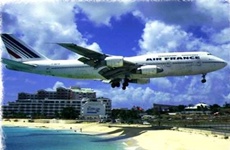Global tourist flows rise 5% in January-August 2013: UNWTO
19 Oct 2013
The number of international tourists grew by 5 per cent between January and August 2013 to reach a record 747 million worldwide, some 38 million more than in the same period of 2012, the United Nations' World Tourism Organisation (UNWTO) said in its latest report.
 The increase in tourist flows worldwide has been driven by strong flows into, Asia-Pacific, Africa and the Middle East and Europe, according to UNWTO's World Tourism Barometer.
The increase in tourist flows worldwide has been driven by strong flows into, Asia-Pacific, Africa and the Middle East and Europe, according to UNWTO's World Tourism Barometer.
The report said demand for international tourism remained strong throughout the first eight months of 2013 while prospects for the last four months of 2013 remained even brighter.
The optimism is based on an evaluation by UNWTO's panel of experts that confirmed a significant improvement in industry confidence during the May-August period.
After a solid start of the year, demand for international tourism maintained strength throughout the Northern Hemisphere peak season, the report said, adding that the June-August period has shown sound results.
''In absolute numbers, international arrivals topped 125 million in both July and August, while in June the 100 million arrivals mark was exceeded for the first time,'' the report noted.
''While global economic growth is in low gear, international tourism continues to produce above average results in most world regions, offering vital opportunities for employment and local economies,'' said UNWTO secretary-general Taleb Rifai. He was speaking at the opening of the European Tourism Forum in Vilnius.
''This (growth in tourism) is particularly important for Europe, where unemployment is a major concern in many destinations and where the tourism sector has been a source of job growth in the last decade,'' he said, adding, ''Furthermore, through its value chain, tourism creates businesses and jobs in many other sectors and produces significant export revenues, which contribute favourably to the balance of payments in many countries.''
Growth in tourist flows has been the strongest in Asia and the Pacific, with average growth of 6 per cent, while South-East Asia put up a robust show with 12 per cent growth, adding some ten million arrivals in the first eight months of the current year.
Africa also showed some consolidation of business with an average 5 per cent increase in tourist arrivals between January and August 2013, led by a 6 per cent growth in tourist arrivals in North Africa – an addition two million - and a 7 per cent increase in tourist flows to the Middle East where arrivals rebounded after two years of decline.
Europe, with an average growth in tourist flows of 5 per cent, benefited the most from the expansion of tourism in the first eight months of 2013, with an estimated 20 million more arrivals in the region, the report said.
Within Europe, which is also the world's largest tourism region, growth in tourist flows has been more significant in Central and Eastern Europe, with growth of 7 per cent and in Southern and Mediterranean Europe where tourist flows rose by an average 6 per cent.
The Americas were at the bottom with four million additional arrivals, a growth of 3 per cent in the first eight months of the year, with North America in the lead with a 4 per cent increase in tourist arrivals.
With very few exceptions, the increased flows of tourists have resulted in increased tourism receipts as well.
The 25 largest international tourism earners have seen their receipts grow by double-digits.
| Top gainers in tourism earnings | |
| Country | Growth in receipts (%) |
| Thailand | 27 |
| Hong Kong (China) | 25 |
| Turkey | 22 |
| Japan | 19 |
| United Kingdom | 18 |
| Greece | 15 |
| India | 14 |
| Malaysia | 12 |
| United States | 11 |
Emerging economies continue to drive international tourism spending, with all BRIC countries reporting double-digit growth. China posted an extraordinary 31 per cent increase in spending, followed by the Russian Federation (28 per cent) and Brazil (15 per cent).
Tourism spending was slower in the advanced economy source markets of Canada (4 per cent), the United Kingdom (2 per cent), France (2 per cent), the United States (1 per cent) and Germany (0 per cent), while Japan, Australia and Italy saw declines in expenditure.






























